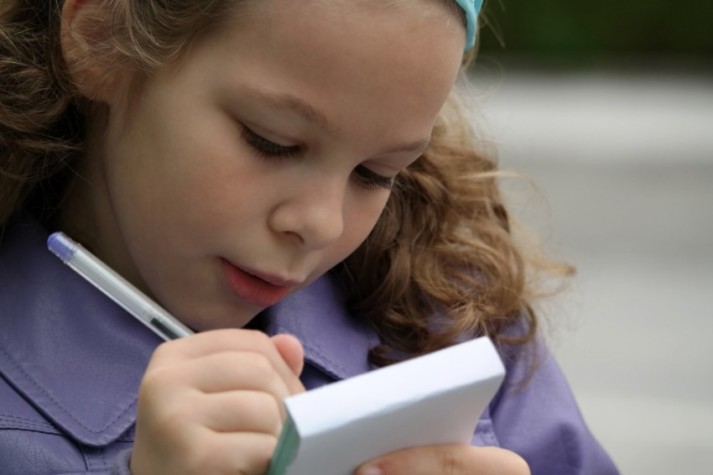2006 winner of the Bechtel Prize, originally published in Teachers & Writers Magazine (2006, Vol. 38, No. 1).
What does imaginative writing do for the writer? If you ask the kids in our classrooms, most of them will tell you that we write to express ourselves. Adults keep on telling them so, in the tone they reserve for indisputable facts. Teachers repeat this formula whether or not they have any genuine feeling for writing and literature themselves. They say it because it’s what’s said, and perhaps also because it conforms to America’s ethic of confession: start talking, preferably about something painful, and continue until you hear the bell. Writing often seems to be regarded as a kind of emotional hygiene; the problem is that treating writing as hygiene makes it feel like a chore as tedious as flossing teeth. So the kids, like the adults, will say that we write for the sake of self-expression not because it’s true, and not because they’ve spent time examining their own experience of writing, but because they know it’s the answer we expect to hear. As a writer, I believe that the question of what writing can do for its practitioners is much too important to be answered reflexively. We need to search for the precise truth of how writing affects us; after all, if our students ask what good writing can do for them, they surely deserve a considered response. What if writing offers the writer something profoundly different, even far more essential, than self-expression? Shouldn’t kids who are actively becoming writers know what they can expect from their engagement in the process?
There’s a catch to the idea of writing as a vehicle for self-expression: it assumes that the writer’s self is solid and distinct enough to be expressed. This is clearly an issue for child writers, caught up as they are in the roil of their own development, but I believe it applies just as much to adults. To be a writer means, perhaps, exactly this: surrendering the defined, expressible self to the wider possibilities of the page. It means giving up the belief that you know who you are, in exchange for a chance at discovering who you are, again and again; after all, the self that jumps up at you from your writing might exceed anything you had previously imagined. For me, and I believe for most other writers, the exhilaration of writing comes exactly when the words pick me up and carry me with a will of their own: when I look back, dizzy with momentum, and can hardly believe that I’m the one who wrote the lines I’m reading. If this is the case—if this is how serious writers experience writing—then those of us who teach writing are doing our students a disservice by not telling them so. We risk misleading them, unless, of course, we don’t actually believe that children can be serious writers.
But children’s special position, right in the thick of formation, might be the ideal place to look for serious writers as well as for ardent readers. Because they still don’t have as many settled preconceptions about who they are, they’re eager to find out, to see where the whirl of words can take them. Kids are primed for the astonishment of meeting the self that stares back at them from the paper. Whether that meeting comes about through their own writing, or through someone else’s, the surprise is the same: the self is created through its encounter with the word.
Everyone who teaches writing has run into them: the kids who say that they don’t have any thoughts, any feelings, any ideas. They have nothing they want to express, they insist, so they won’t write. By seventh or eighth grade, when so many kids have been discouraged by years of negative feedback, when they sometimes start to describe themselves with words like “stupid,” you might find that half the students in a class will sit glumly holding their pencils, or at most scrawl a few resentful lines. If you believe, as I do, that all kids have the potential to create beautiful, exciting writing, then it can be terribly frustrating. How can we help them over the inhibitions holding them back?
“Listen,” I tell the eighth-graders in my writing workshops. “Most people think that writing comes from ideas. They wait around for an idea, and it doesn’t come, so they don’t write anything. But the more you write, the more you’ll discover that the exact opposite is true: ideas come from writing. Once you start writing, start and keep going without stopping to think, without worrying whether your work is good or bad, you’ll find all kinds of ideas you never knew you had….” This is why timed writing exercises can be such a wonderful force for change in the classroom; the kids don’t have enough time to wait for something to express. I often write lists of provocative questions on the board, related in some way to the theme of the poem or story we’re reading that day: Does the soul have the same shape as the body? Is your body something that brings you beauty and experience, or is it a trap and a limitation? I make sure to tell the kids that they don’t need to answer the questions; they’re just a jumping-off point, something they can refer to if they feel like it. Then, once a piece of paper is ready on every desk, once a sharpened pencil is raised in every hand, I tell them to begin, to write without pausing until the time is up. Although I say it’s for five minutes, the kids are often working so intently that I’ll stretch it out, pretending that it’s only been five minutes when it’s really been eight or nine. I fudge the time because I know that even kids who won’t ordinarily write at all will suddenly find strange, lyrical, insightful gusts of prose on the paper in front of them at the end of the exercise. They’ll write things in a few minutes that they would never write if I told them to express themselves and gave them an hour to do it. I know that the more regularly I do these exercises, the better the results will be, as the kids start to tap into the hidden depths of their own minds. Generally, the very best work the kids do, the work that flares with individual brilliance and originality, will come out of these exercises. Some of these sparks will come from kids who normally seem vague, low-achieving, even dull; the surprise of their own writing can start to generate new selves for them, selves which have very different qualities.
I stretch out the time, because the process is so beautiful that I hate to see it end.
In her wonderful book Invisible Guests, the developmental psychologist Mary Watkins writes, “the self is an organization of perspectives.” This makes perfect sense, if you think of the wild call of children everywhere, “Look at me!” Every time a child asks us to look, she is at work on the crucial enterprise of gathering the perspectives that will let her come into fuller being. Once we turn to look, she will see us seeing her. She’ll make the empathic leap (“How do I seem to him? How do I look at this moment, riding this blue bike, under these trees? Am I doing a good job? Is it fun to watch me?”) that lets her assimilate our vision of her into her own self-image. The way we see her gives her a new dimension, a new facet of being, and this will happen anew every time we answer her call to look. With one glance we’ll see her as delightfully silly; with another we’ll see her as a nuisance, maybe because she’s distracting us from our conversation; both looks will become part of her. Children bring the passion of great collectors to this work. Their demands that we look, and look again, sometimes wear on even the adults who love them best. But we should remember how dangerous and difficult their undertaking really is: kids rarely have sufficient defenses to reject wounding perspectives. They absorb every gaze they can get, whether that gaze is poisonous or thrilling. They bring it home to the self, because the drive to become will not let them rest.
Understanding the self in these terms offers us a revelation; suddenly the usefulness of imaginative literature becomes brilliantly apparent. Watkins writes, “the importance of the novel and newspaper is that they create the self by allowing the readers to adopt other perspectives.” In other words, the novel, the poem, the character all look back at the reader from strange angles, and the more they look the more the reader expands and ramifies to meet their gaze. That wonderful feeling, of loving the voice that speaks to us from a book, and even of being loved by that voice in return, isn’t an illusion. By giving us a new perspective on ourselves, a new point of view, the words we read are helping to create us; they become part of our inner organization. They might even create us as people with flights and turns of feeling and thought we never previously looked for; they promise to make us bigger, freer, more authentic human beings. What could be more truly loving than that?
Do you remember the ravenous love you felt for stories in childhood, the shimmering glamour that your favorite books had for you? The excitement you felt was another version of Look at me! The characters in those books looked back at you from new and amazing points of view; maybe they gave you facets of yourself that even the people you loved, your family and friends, couldn’t give you. Maybe they saw you as heroic, or inspired, or elegant, or subversive; it’s fairly certain that they almost never saw you as dumb, boring, or infantile. If you were unlucky enough to have already collected destructive views of yourself from the people around you, the books you loved could help by showing you alternative perspectives on yourself. They could create you all over again, with fresh potential.
The process of accumulating perspectives probably begins in infancy, when, as D.W. Winnicot observed, we first internalize our mother’s gaze, and so gain the ability to be alone with ourselves. Certainly the work of self-creation is most pressing in childhood; children are painfully vulnerable until they acquire enough positive perspectives on themselves to give them a basic sense of security. But once it’s been set in motion, this project has no set stopping point. With each new novel we read, with each story we overhear on a bus, even with each new voice that appears from out of nowhere in our own writing, startling us with tones we never heard before, new perspectives flock home.We become, and become again.
In childhood we clamor for people to look, because our effort to create strong, active selves is still freshly begun, fragile and anxious. But even in adulthood we can keep on gathering further complexities, unsettling our own established boundaries in communion with new voices. When we find a new writer we really love, we might let go of some of our old ideas about ourselves to make room for what this encounter can tell us. Self-creation continues, that is, unless we spurn the words that look back at us; unless we drop the book, refuse to empathize with the character. By encouraging children to make reading and writing an ongoing part of their lives, we are proposing to them a lasting creative endeavor. We’re telling them, in effect, that their selves will always be too busy gathering new furls of creation to sit politely still, as if posing for a school portrait. That is, we’re telling them that their richly complicating selves might never be passive enough or static enough to be expressed.
I recently taught a gifted eighth-grade student, Krystal, in a writing workshop in the Bronx. When I asked the kids, on my last day at their school, to write for a few minutes on what writing meant to them, Krystal jotted down the line, “The pen has become the character and the words, the adventure.” The pen, in this image, has a voice and vitality of its own, an independence. It almost feels like a person. Autonomy makes it separate enough from her for an authentic relationship, much deeper than mere narcissistic self-regard, to form between them. Krystal is giving her own writing enough room to show her real love. She allows it enough space to look back at her, the freedom to bring her a new facet of herself. And then because she doesn’t treat it as something she controls it can take her in unfamiliar directions, even in directions that she never knew were there. Going on an adventure, after all, is not at all the same thing as re-exploring habitual territory, the well-known chambers of the mind. An adventure is precisely what we cannot anticipate from one moment to the next.
Krystal is hardly alone in her experience of writing; there are abundant accounts of writers meeting with an imaginative force that conducts their work along unexpected paths. Watkins quotes a saying from the marvelous Russian poet Marina Tsvetaeva that strikes me as intimately related to Krystal’s: “We dream and write not when we please but when it pleases.” This difficult, indefinable “it” has been addressed with a multitude of names by many different writers: where Krystal calls it the pen, the poet César Vallejo, in Trilce, calls it the crystal. “It wounds when they force it,” Vallejo warns, “And no longer shows animal affection.” The characters in the stories we read will always have enough freedom to gaze back at us, often with great tenderness, unless we willfully deny it to them. After all, we can’t even pretend to control them; we smile at them with sudden joy when they do something to surprise us. But the characters in the stories we write are more sensitive. We have to be careful to give them enough autonomy to create us, to show us animal affection, rather than crowding them with demands that they tell us only what we already know.
I know that my writing has created me, not just once, but more times than I can count. In the deepest sense of the words, I owe writing my life: not, that is, my biological existence, my continuing heartbeat, but the life of my real self. I never know who I am as intensely as I do when I meet the person who twists out of the page. I don’t think it’s any exaggeration to say that writing can be the source of our truest vitality: it can give us our unknown potential, make us into the people we were meant to be. It can save us from the emotional death of never discovering who we actually are, of living with half a self.
AT the very beginning of my teaching in the public schools, before I really knew what I was doing, I had a shy third-grade student named Taisha. In session after session, Taisha wrote nothing. Her regular teacher told me not to bother with her; Taisha, she said, was at kindergarten level, incapable of real writing. Then, out of the blue, Taisha wrote a poem:
How the time goes:
Sometimes the clock goes fast,
Sometimes slow.
And at the door of the eye
When the clock goes fast
My eye blooms out of my face.
The clock goes faster, and
My mother says it’s morning
When it’s really dark. The Taisha who wrote this was a new Taisha, one who didn’t exist before the poem. If she created it, it’s at least as true to say that it created her. It made her into a star writer, equal to the most talented kids in a very talented class; it made her into someone with a gift for imagery and language, with rich and powerful emotions. She was even more amazed than I was to meet the girl who emerged from these unexpected lines. And by emerging in this astonishing way, she taught me the most important thing I have ever learned about teaching writing.
Bibliography
Vallejo, César. Trilce. 1922. Trans. Clayton Eshleman.New York: Marsilio Publishers, 1992.
Watkins, Mary. Invisible Guests: The Development of Imaginal Dialogues.Woodstock, CT: Spring Publications, 2000.
Winnicot, D.W. “The Capacity to be Alone.” International Journal of Psycho-Analysis 39 (1958): 416–420.



